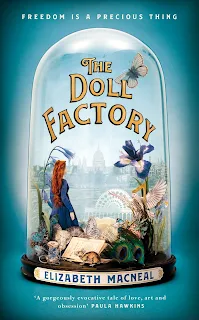Set in London in 1850, The Doll Factory by Elizabeth Macneal is a Victorian tale of art, aspiration and obsession. Twins Iris and Rose work in a shop selling handmade porcelain dolls, Iris painting their faces and hands and Rose making their fine detailed garments. Iris dreams of becoming an artist and a chance encounter with a Pre-Raphaelite painter changes her life forever.
Louis Frost is bewitched by Iris' unique beauty and asks her to model for him in exchange for drawing and painting lessons.
Meanwhile, a taxidermist by the name of Silas has also noticed Iris' beauty and begins to obsess about her. He is a collector and a sinister character that wants Iris for himself. His fixation drives the threat the entire way through the novel.
All of the characters are swept up in the excitement of the upcoming Great Exhibition of 1851, each of them seeking to have an item accepted for display.
Dickensian London really comes to life on the page in The Doll Factory. With mentions of turtle soup, street urchins and the vivid hustle and bustle, Macneal was able to transport me back in time so convincingly I could almost smell the street litter.
What caught me by surprise, was that the art sub-plot was reminiscent of Beauty in Thorns by Kate Forsyth. If I'd known how much the plot centred around art, the Pre-Raphaelites and the Great Exhibition, I might have postponed reading this for a year or two. Having read and enjoyed Beauty in Thorns in March last year, the overlap in setting and subject matter seemed to hinder my enjoyment of The Doll Factory. Definitely not the fault of the author, just a misstep in my own reading schedule.
The Doll Factory by Elizabeth Macneal is recommended reading for those who enjoy their historical fiction dark and Dickensian with a splash of art.
Carpe Librum!
Louis Frost is bewitched by Iris' unique beauty and asks her to model for him in exchange for drawing and painting lessons.
Meanwhile, a taxidermist by the name of Silas has also noticed Iris' beauty and begins to obsess about her. He is a collector and a sinister character that wants Iris for himself. His fixation drives the threat the entire way through the novel.
All of the characters are swept up in the excitement of the upcoming Great Exhibition of 1851, each of them seeking to have an item accepted for display.
Dickensian London really comes to life on the page in The Doll Factory. With mentions of turtle soup, street urchins and the vivid hustle and bustle, Macneal was able to transport me back in time so convincingly I could almost smell the street litter.
What caught me by surprise, was that the art sub-plot was reminiscent of Beauty in Thorns by Kate Forsyth. If I'd known how much the plot centred around art, the Pre-Raphaelites and the Great Exhibition, I might have postponed reading this for a year or two. Having read and enjoyed Beauty in Thorns in March last year, the overlap in setting and subject matter seemed to hinder my enjoyment of The Doll Factory. Definitely not the fault of the author, just a misstep in my own reading schedule.
The Doll Factory by Elizabeth Macneal is recommended reading for those who enjoy their historical fiction dark and Dickensian with a splash of art.
Carpe Librum!



































